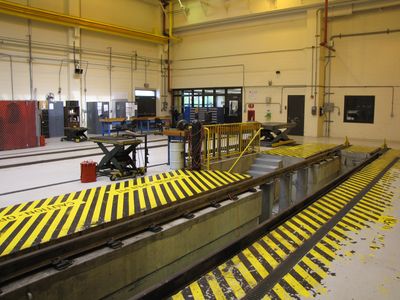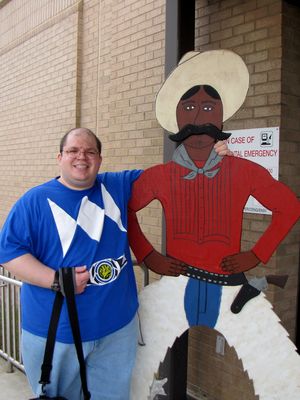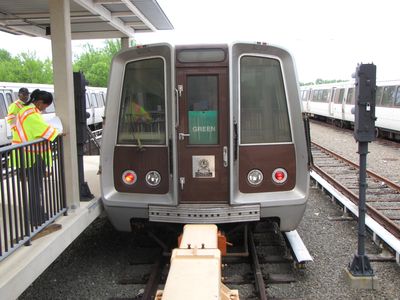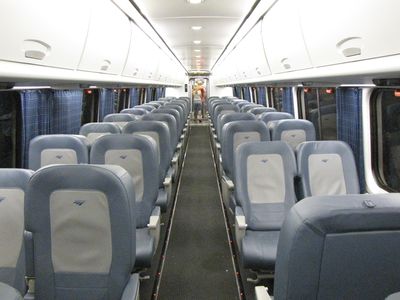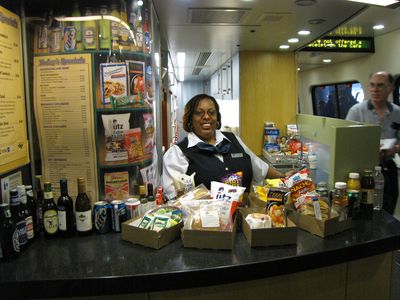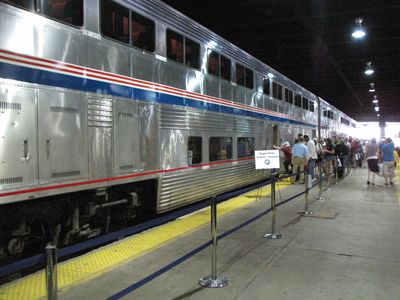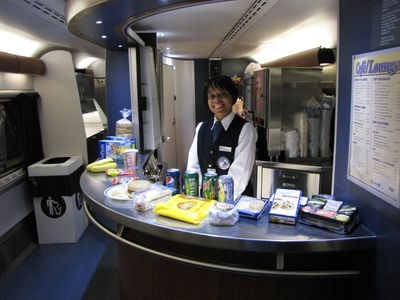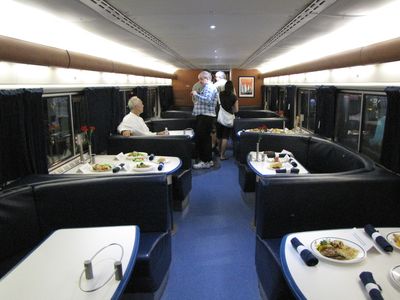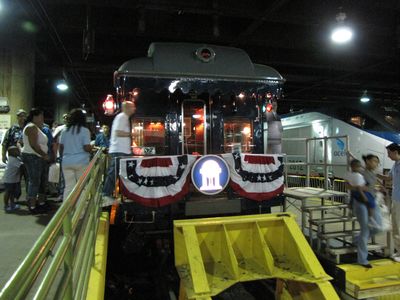No more beautiful a day to get kicked out of the WMATA Rail Rodeo…
10 minute read
May 11, 2009, 8:05 PM
So Saturday was fun. I got together with Matthew Tilley, and we went to the WMATA Rail Rodeo at Branch Avenue Yard, went up to Dupont Circle (I had to stop by my office), and then checked out Amtrak’s National Train Day events at Union Station. The day didn’t go quite as expected, but we still had a lot of fun.
Starting out, of course, I picked Matthew up at his house. This would put my new GPS device, an early birthday present from my parents (thanks, Mom!), to the test. It did very well, and sent me on a very quick and easy route there, and one I would not have thought of – essentially the back way into Matthew’s neighborhood.
After I picked Matthew up, we got back on the Beltway, and rode over to Branch Avenue Yard to watch the rail rodeo in action. The WMATA Rail Rodeo, for those not familiar, is an annual event where Metro’s rail employees get to show off their skills in various competitions. The event is usually open to the public. I’d been wanting to go to the Rail Rodeo for some time, and this year, I finally did my homework ahead of time, writing Metro’s customer service department back in late February to find out the tentative date, and following up in late April to confirm that date.
Arriving at Branch Avenue Yard, we stopped at the security checkpoint at the gate, and indicated that we were here to see the rail rodeo. The security guard asked if we worked for Metro (we didn’t), checked my driver’s license, and waved us in. We parked, and asked a few Metro employees we found where the activity was. They weren’t too sure themselves. Okay, fine. We’re resourceful. So we went about finding out for ourselves. Matthew and I soon found ourselves in the shop building, where WMATA mechanics perform routine maintenance on the trains.
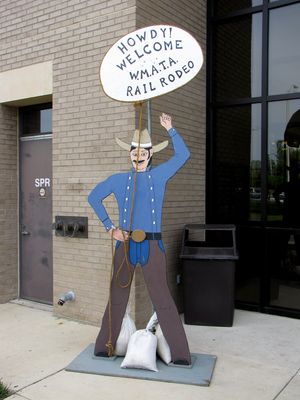

Wooden cowboy cutouts outside the shops building, welcoming people to the Rail Rodeo.

Train service bays. I was surprised to see this room empty, as others’ photos from past Rail Rodeos indicated that Metro usually puts a train up on a lift for people to see.

Mockup of train doors, presumably part of the competition. In the extreme left of the photo, if you look carefully, you can see two mockup rail cars stacked at left. These are presumably also part of the competition, and they had car numbers: 5000 and 5001. In other words, CAFs. However, the illustration of a car end on these cars looked very Rohr-like. Details, details…
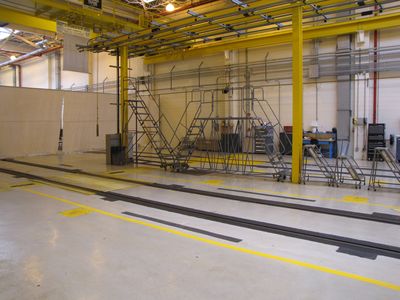
More service bays. The far end of this room was cordoned off for a meal that Metro was serving participants.
And then we at last found some people who knew what they were doing. Turned out that we found the judges’ table for the mechanics’ competition. Unfortunately, we were unable to stay for very long, owing to OSHA requirements – we didn’t have the correct footwear (I was wearing my Crocs, and Matthew was wearing sneakers). However, the gentleman that escorted us out of the shops was incredibly friendly, and described all of the various competitions that the mechanics would be engaging in. Most intriguing to me was the “mystery box” competition, where mechanics were presented with a closed box, and using their tools, had to determine not only what the components of the box were, but what the problem was with those components. He also explained that the main benefit of eight-car trains, mechanically, was that they could be used as their own recovery vehicle. Thus if an eight-car train goes down and has to be recovered, they can use the remaining good cars to remove the train from the line. I remembered back to about a year ago, when I was on Breda 4051 when it broke down, and how they had to use a second train to remove our train from the line. He also explained how sometimes a train must be operated from the third car rather than the first during a recovery. In that case, the motorman is in the third car’s cab (the next forward-facing cab after the lead car), while another employee is in the lead car giving stop and proceed instructions to the motorman via radio.
All in all, we learned a lot. He also kind of indicated where the rail car events would be held, but questioned how much success we would have in watching.
After we parted company, Matthew and I continued figuring out where things were. Matthew was understandably a little nervous now about continuing to find out what was going on, but I reassured him by saying that the worst that they could do was to ask us to leave. After all, we weren’t trespassing – the security guard allowed us entry, and we were quite upfront about who we were – we were members of the public, and rail enthusiasts. Additionally, we were under the impression that this event was indeed open to the public, and thus that we were supposed to be there.
We ended up at the far end of the yard, near the lead tracks to the mainline. There, we observed a six-car train consisting of, front to back, Alstom 6094, 6095, 6088, 6089, 6141, and 6140, leave the yard signed as a Green Line train to Greenbelt, to enter revenue service. Once the train had passed, we walked near the set of tracks that the train had just passed on. From the road, I called to the gentlemen in the yellow safety vests. One approached us, and we asked where the rail car events were being held. He indicated that those events were being held at the other end of the yard. So we went down that way.
Along the way, we saw trains in storage, as well as all sorts of work equipment:
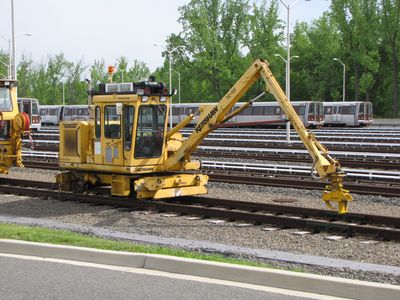
TC-02, a Bridge Crane vehicle.
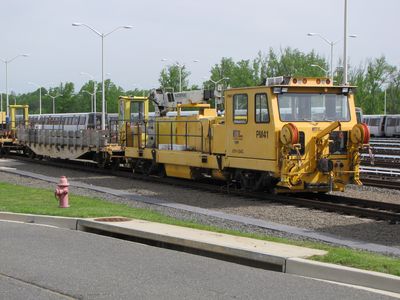
PM41 (right), and F-507 (flat car, left).
We eventually ended up at the Yard Operations building, where we posed with the cowboy cutouts:
We went into the Yard Operations building, and eventually found the events. There was an obstacle course at the far end, as well as an announcement competition. They weren’t running the obstacle course when we were there, but they were indeed doing announcements. There, the operators sat in the cab and made announcements while a judge made notes on their performance. The strangest announcement I heard was for a Red Line train to Shady Grove. This is a part of Metro I’m quite familiar with, as Red Line to Shady Grove is my morning commute. The announcement went like this:
Attention, customers. The Farragut North and Dupont Circle stations are closed. The next station will be McPherson Square. The next station is McPherson Square.
I heard that, and I was like, whaaaaaaaaa? After all, I’ve been on the Red Line on more than one occasion where stations were closed and rendered impassable for whatever reason, and in those cases, the trains generally serviced the last station that they could, terminated, and then entered service in the other direction (i.e. a Glenmont train would become a Shady Grove train and be on its way). I can’t imagine what sort of catastrophe might occur that would require a Red Line train to use the A&C Connection (running between Farragut North and McPherson Square on Track 2) with passengers. Normally, that connection is only used for trains on non-revenue runs, such as the Money Train, or swapping trains between lines. Seriously, to have to leave the Red Line (A Route) entirely and go to a Blue/Orange Line station (C Route) would have to be something pretty serious.
We also got to get some fun yard photos…
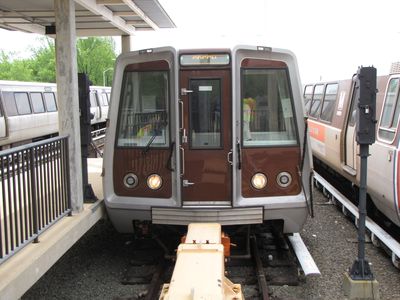
Breda 3217. The train operator is competing in the announcements competition. The judge is visible in the right-side window.
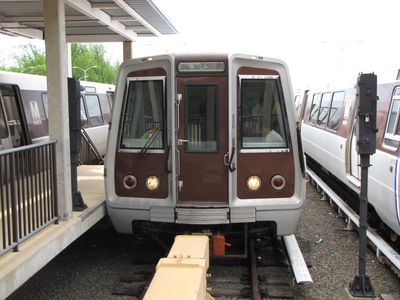
CAF 5139. Again, announcement competition is underway, with the judge seated at the opposite side of the cab from the operator.
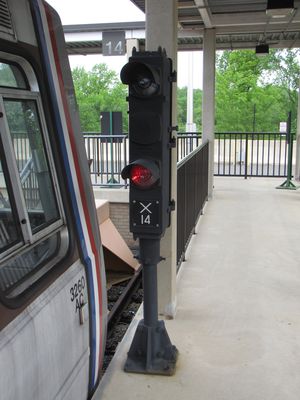
Yard signal at the end of the storage track. This signal is always red.
We also got into a great conversation with a train operator about various odds and ends. Much to their credit, and contrary to Metro’s normally well-earned reputation for crabby customer service, everyone at the rodeo was incredibly friendly. Not one rude individual in the lot of them.
Eventually, one of the supervisors, wearing the special 2009 WMATA Rail Rodeo shirts (what I would do to get one of those shirts!), asked us why we were there. Again, I explained that we were members of the public there to watch the rail rodeo. Now is where we were finally set straight. This also explained why we were the only non-employees to be at the Rail Rodeo, for an event that we were led to believe was open to the public. I had thought it was simply poor turnout by the public because Metro had not promoted the event this year. Turned out that this year, they weren’t running the rodeo as a family event, but rather just as an employee event. And thus they asked us to leave, and they got a retired train operator to escort us back to the car. Fair enough.
Obviously there had been a breakdown in communications somewhere along Metro’s chain of command, and thus why we were led to believe by customer service that the event was open to the public and allowed entry by the security guard, but that the event was actually not public. Unfortunately, such seems to be typical of Metro, and so while we were disappointed, we were also not all that surprised. However, we did have a great conversation with the gentleman who escorted us back to our car.
However, that wasn’t the end of our day. Not by a longshot. Leaving Branch Avenue Yard, we drove over to Branch Avenue station, and caught the train. There, we got Alstom 6104, part of the original carpetless Metro pair. How cool was that! We then rode over to Dupont Circle, since I had to check on something at work. After swinging by work, we got back on the train, and rode over to Union Station, where the National Train Day event was in full swing. Amtrak was showing off some trains, and so we got to see a number of trains on display.
On the way, we saw someone make a stickered statement on CAF 5031 about Metro’s policy of turning back trains at Grosvenor during rush hour:
That sticker read:
This is an asinine policy.
The trains that go to Shady Grove are packed, and the trains that go to Grosvenor are half empty. This policy only serves the purpose of creating a comfortable ride for the wealthy residents of Northwest DC and Bethesda. Please change this.
All I have to say is, that takes guts to do – not only to write it up, but to sticker it on, though unfortunately, I doubt anyone in a position to change it will see it (though perhaps I’m helping with this Journal entry). And I for one agree that turning back Red Line trains like that is a poor idea, though I’m a victim of the other side, as Metro also turns trains back at Silver Spring, which leaves me with reduced service to my home station of Glenmont. I’ve been put in the situation of explaining to friends that not every Red Line train goes to my house. I’m like, “Not that Red Line train!” regarding Silver Spring trains. But anyway…
Arriving at Union Station, we had to wait in line:
And then we got to tour the Acela Express.
Leaving the Acela, we got to see Superliner and Amfleet cars. I was quite familiar with the Superliner cars, since that’s what the Capitol Limited uses, and that’s what Mom and I took when we went to Chicago in 2007. Interestingly enough, Matthew and I ran into same room attendant that Mom and I had on the westbound trip. We didn’t, however, run into Lou, our room attendant from the eastbound trip. Turns out Lou was at a conference in Los Angeles…
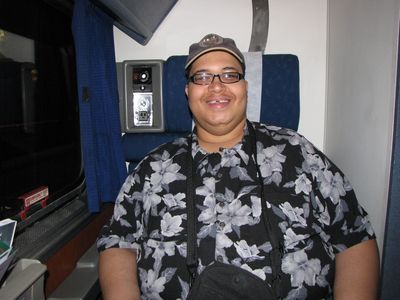
Matthew is all smiles in a Superliner Roomette seat.
Meanwhile, much to my surprise, the Superliner dining cars had been renovated since Mom and I took our 2007 trip. Take a look…
Fancy! And then finally, we got to see the Amfleet cars.
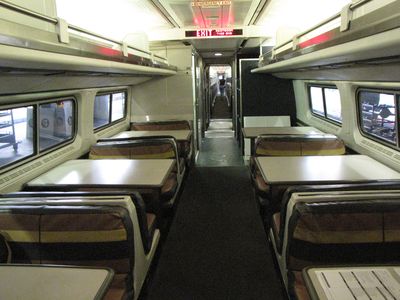
Amfleet dining car. This is more like how the Superliner dining cars looked when Mom and I traveled.
And lastly, we got a peek at the rail car used in the Obamas’ inauguration train ride:
And that was it! From there, Matthew and I rode back to Branch Avenue, and then I took him back home. All in all, I’d say we had a fun time, and my GPS has proven itself to be a worthy tool in navigating unfamiliar areas in my local area.
Web site: National Train Day
Song: "Pain" by Stereomud - after all, Randi Rhodes returned to the air today! Hooray!
Quote: It's funny... I'm sure most people probably think about their GPS devices as tools for helping them when they go traveling out of their local area. I've found it most helpful in navigating unfamiliar sections of my own local area. I've come to realize pretty quickly that printed Google directions are not exactly safe to use when driving in the city. And I've figured out how to report errors and inaccuracies in the maps when I find them. Thus I reported that Tiny Road in Stuarts Draft is still on the maps (the road was removed in 2005), and also reported a wrong position for the Food Lion in Stuarts Draft.










